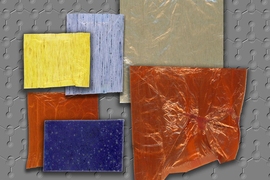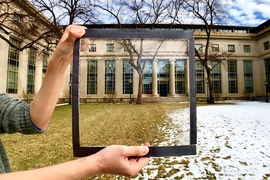In the quest to make buildings more energy efficient, windows present a particularly difficult problem. According to the U.S. Department of Energy, heat that either escapes or enters windows accounts for roughly 30 percent of the energy used to heat and cool buildings. Researchers are developing a variety of window technologies that could prevent this massive loss of energy.
“The choice of windows in a building has a direct influence on energy consumption,” says Nicholas Fang, professor of mechanical engineering. “We need an effective way of blocking solar radiation.”
Fang is part of a large collaboration that is working together to develop smart adaptive control and monitoring systems for buildings. The research team, which includes researchers from the Hong Kong University of Science and Technology and Leon Glicksman, professor of building technology and mechanical engineering at MIT, has been tasked with helping Hong Kong achieve its ambitious goal to reduce carbon emissions by 40 percent by 2025.
“Our idea is to adapt new sensors and smart windows in an effort to help achieve energy efficiency and improve thermal comfort for people inside buildings,” Fang explains.
His contribution is the development of a smart material that can be placed on a window as a film that blocks heat from entering. The film remains transparent when the surface temperature is under 32 degrees Celsius, but turns milky when it exceeds 32 C. This change in appearance is due to thermochromic microparticles that change phases in response to heat. The smart window’s milky appearance can block up to 70 percent of solar radiation from passing through the window, translating to a 30 percent reduction in cooling load.
In addition to this thermochromic material, Fang’s team is hoping to embed windows with sensors that monitor sunlight, luminance, and temperature. “Overall, we want an integral solution to reduce the load on HVAC systems,” he explains.
Like Fang, graduate student Elise Strobach is working on a material that could significantly reduce the amount of heat that either escapes or enters through windows. She has developed a high-clarity silica aerogel that, when placed between two panes of glass, is 50 percent more insulating than traditional windows and lasts up to a decade longer.
“Over the course of the past two years, we’ve developed a material that has demonstrated performance and is promising enough to start commercializing,” says Strobach, who is a PhD candidate in MIT’s Device Research Laboratory. To help in this commercialization, Strobach has co-founded the startup AeroShield Materials.
Lighter than a marshmallow, AeroShield’s material comprises 95 percent air. The rest of the material is made up of silica nanoparticles that are just 1-2 nanometers large. This structure blocks all three modes of heat loss: conduction, convection, and radiation. When gas is trapped inside the material’s small voids, it can no longer collide and transfer energy through convection. Meanwhile, the silica nanoparticles absorb radiation and re-emit it back in the direction it came from.
“The material’s composition allows for a really intense temperature gradient that keeps the heat where you want it, whether it’s hot or cold outside,” explains Strobach, who, along with AeroShield co-founder Kyle Wilke, was named one of Forbes’ 30 Under 30 in Energy. Commercialization of this research is being supported by the MIT Deshpande Center for Technological Innovation.
Strobach also sees possibilities for combining AeroShield technologies with other window solutions being developed at MIT, including Fang’s work and research being conducted by Gang Chen, Carl Richard Soderberg Professor of Power Engineering, and research scientist Svetlana Boriskina.
“Buildings represent one third of U.S. energy usage, so in many ways windows are low-hanging fruit,” explains Chen.
Chen and Boriskina previously worked with Strobach on the first iteration of the AeroShield material for their project developing a solar thermal aerogel receiver. More recently, they have developed polymers that could be used in windows or building facades to trap or reflect heat, regardless of color.
These polymers were partially inspired by stained-glass windows. “I have an optical background, so I’m always drawn to the visual aspects of energy applications,” says Boriskina. “The problem is, when you introduce color it affects whatever energy strategy you are trying to pursue.”
Using a mix of polyethylene and a solvent, Chen and Boriskina added various nanoparticles to provide color. Once stretched, the material becomes translucent and its composition changes. Previously disorganized carbon chains reform as parallel lines, which are much better at conducting heat.
While these polymers need further development for use in transparent windows, they could possibly be used in colorful, translucent windows that reflect or trap heat, ultimately leading to energy savings. “The material isn’t as transparent as glass, but it’s translucent. It could be useful for windows in places you don’t want direct sunlight to enter — like gyms or classrooms,” Boriskina adds.
Boriskina is also using these materials for military applications. Through a three-year project funded by the U.S. Army, she is developing lightweight, custom-colored, and unbreakable polymer windows. These windows can provide passive temperature control and camouflage for portable shelters and vehicles.
For any of these technologies to have a meaningful impact on energy consumption, researchers must improve scalability and affordability. “Right now, the cost barrier for these technologies is too high — we need to look into more economical and scalable versions,” Fang adds.
If researchers are successful in developing manufacturable and affordable solutions, their window technologies could vastly improve building efficiency and lead to a substantial reduction in building energy consumption worldwide.










